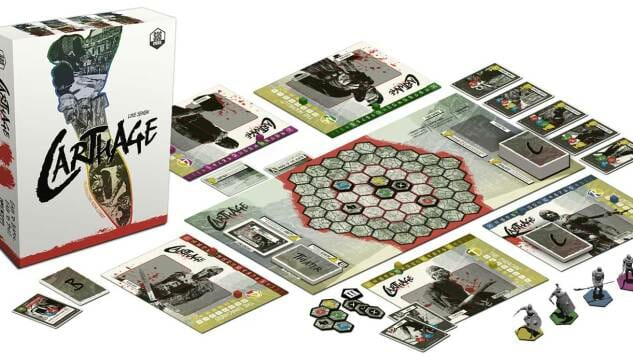The Board Game Carthage Doesn’t Offer the Player Enough Control
Art courtesy of SAS Creative
Carthage takes the deckbuilding mechanic popularized by Dominion and turns it into a game of mortal combat on a hexagonal board, played out over multiple rounds where players get the opportunity to upgrade their decks as the game progresses and do more damage to opponents or incorporate new tactics. It’s a clever twist on what has become a hackneyed core ruleset, and really ramps up the interactivity of this style of deckbuilders, although it doesn’t give players enough control over how they build those decks.
Players in Carthage each start with similar decks of ten cards, and draw five for each round. Each player will play all five of those cards, which allow for movement, damage, adding hit points (‘armor’), or gaining ‘favor’ points from the audience that can be used to purchase cards at the end of the round. The cards in the starter decks are, unsurprisingly, fairly weak, so you’re sort of slapping each other back and forth without doing a lot of lasting damage. The cards that you buy are more powerful, some slightly so and some extremely so, including cards that introduce the possibility of tactical moves through sequential benefits—for example, move one space, hit an adjacent opponent for damage, then move three spaces (i.e., run away!), maybe even hit another opponent for damage.
The battle arena is hexagonal and comprises a bunch of hexagonal spaces, with an outer ring and an inner, smaller hexagon, with the two sections coming into play in certain scenarios. In each round of battle, the players draw a new Theater card that changes one or more rules for that specific round, such as one that says players can’t cross the boundary between the outer ring and the inner one, or cards that give all players extra Favor points or dings each player a hit point. The base game also comes with many scenarios to alter game play, from different setups to the introduction of non-player Beasts that also fight in the same arena, causing confusion and delay for the various players.
-

-

-

-

-

-

-

-

-

-

-

-

-

-

-

-

-

-

-

-

-

-

-

-

-

-

-

-

-

-

-

-

-

-

-

-

-

-

-

-









































